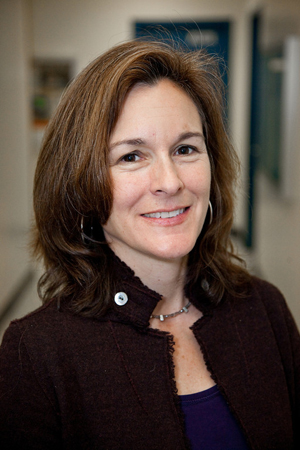
Tracey Woodruff
Tracey Woodruff, PhD, MPH, director of the UCSF Program on Reproductive Health and the Environment, says she is surprised and concerned about findings in a new study that shows pregnant women have multiple chemicals in their bodies.
The study, published today in Environmental Health Perspectives, marks the first time that the number of chemicals to which pregnant women are exposed has been counted.
Woodruff offers these tips on how everyone can avoid environmental toxins from contaminating their bodies and adversely affecting their health.
- Reach for a mop. Lead, pesticides and flame retardants are present in dust. Sweeping or dusting may spread toxins into the air instead of removing them from your home.
- Don’t spray bugs. Avoid pesticides, which are toxic chemicals made to kill unwanted insects or weeds. Instead, keep your home clear of food crumbs and spills. Use baits and traps instead of sprays, dusts or bombs. Avoid using chemical tick-and-flea collars or dips for your pets.
- Avoid dry-cleaning clothes. Most cleaners use a chemical called perchloroethylene (PERC), which can pollute the air in your home. Use water instead. Most clothes labeled as “dry clean only” can be washed with water. Hand wash them or ask your dry cleaner to wet clean them for you.
- Check air quality forecasts. Exercise as far away as possible from sources of air pollution (such as traffic or factories) and do not exercise on bad air quality days.
Individual actions alone cannot prevent exposure to substances in the environment that harm our health. These can only be prevented by public policies that stop chemical pollution. For more resources and information on how to get involved, visit
Toxic Matters.
Toxins in Pregnant Women
Environmental health scientist Tracey Woodruff reports that pregnant women have many toxins in their bodies.
Toxic Matters is an online and print resource created by an alliance of partners led by the UCSF Program on Reproductive Health and the Environment (PRHE). It’s designed to help consumers make smarter decisions about substances that can harm general and reproductive health. The brochure and web page include tips on reducing exposure to metals and synthetic chemicals in everyday life — at home, at work, and in the community — and provide links to other sources of detailed information.
“We’ve identified key areas where exposures are constant and avoidable,” said Woodruff, director of PRHE. “Although certain groups are most vulnerable, toxic substances in the environment affect every person, every day and are the responsibility of all of us.”
Photo by Susan Merrell
Related Links
 Tracey Woodruff
Tracey Woodruff